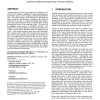Free Online Productivity Tools
i2Speak
i2Symbol
i2OCR
iTex2Img
iWeb2Print
iWeb2Shot
i2Type
iPdf2Split
iPdf2Merge
i2Bopomofo
i2Arabic
i2Style
i2Image
i2PDF
iLatex2Rtf
Sci2ools
89
Voted
SMA
1999
ACM
1999
ACM
Generation of swept volumes of toroidal endmills in five-axis motion using space curves
Accurate prediction of the swept volume of a cutting tool is essential in NC verification algorithms for detecting deficiencies in a proposed tool path, such as gouging, undercutting and interference. This paper explores a new technique for generating the swept volume of a toroidal endmill, and analyzes the results obtained for two test cases. For a given tool location along a path, a curve on the cutting surface of the tool is identified that rs:presents the imprint of the tool on the machined surface. This curve will be designated a space curve as it is defined in 3D spa.ce. The method relies on forward difference information obtained from a G-code or cutter location data file in order to compute the space curves. Once several su.ccessive space curves have been identified, a facetted surface model of the footprint of the tool along a pass may be readily calculated and compared with the design surface. The method has b,een verified for two test cases: a) 5-axis tool path on a hemisph...
SMA 1999 | Solid Modeling | Space Curves | Tool | Tool Paths |
| Added | 03 Aug 2010 |
| Updated | 03 Aug 2010 |
| Type | Conference |
| Year | 1999 |
| Where | SMA |
| Authors | David Roth, Sanjeev Bedi, Fathy Ismail |
Comments (0)

